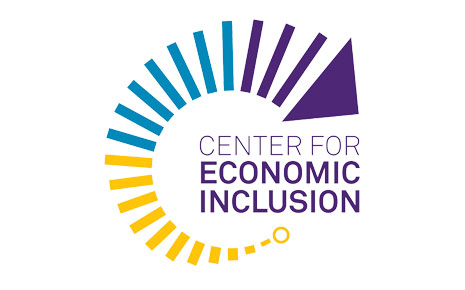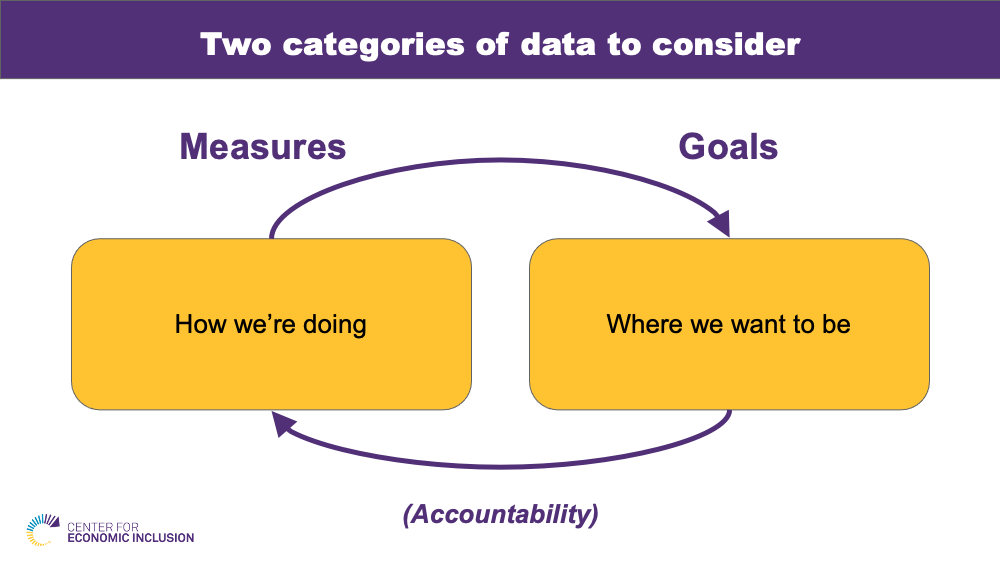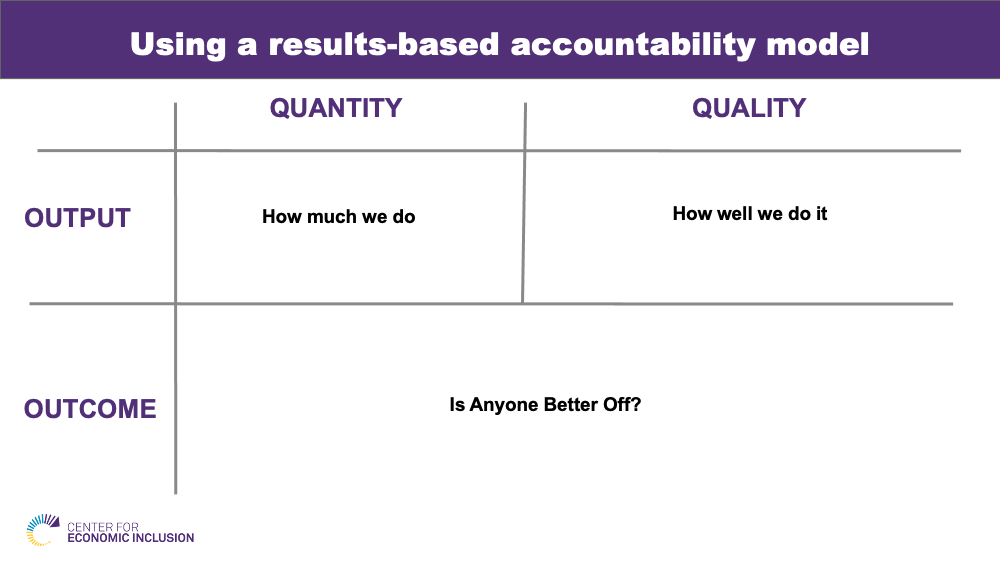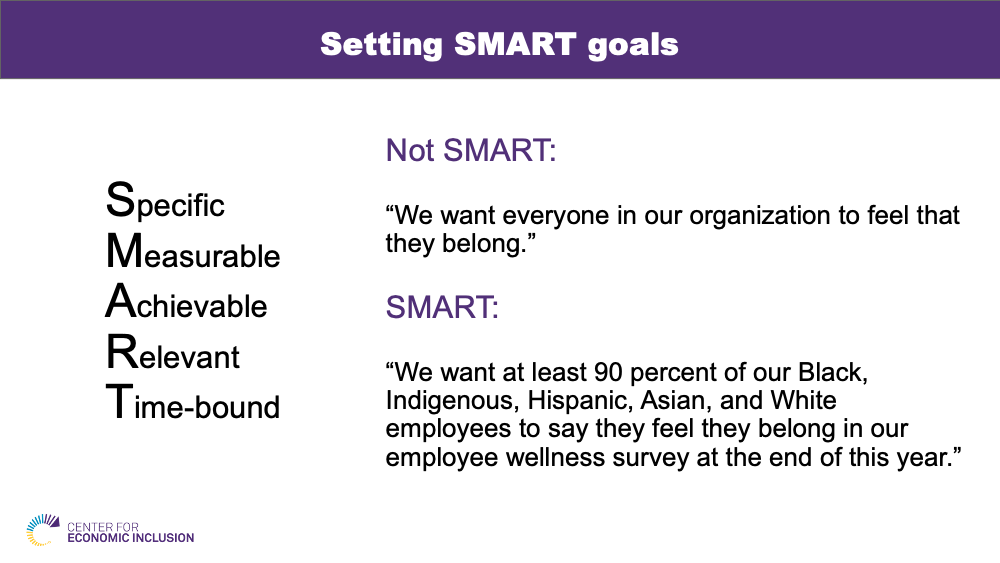
How Businesses Can Begin to Use Quantitative Data to Advance Racial Equity
January 30, 2022
How Businesses Can Begin to Use Quantitative Data to Advance Racial Equity
By Nathan Arnosti, Director of Analytics, Center for Economic Inclusion
More businesses locally and across the country are recognizing that advancing racial equity and inclusion in their workplace isn’t just the right thing to do – it’s also a competitive necessity. As our country continues to become more racially diverse, the businesses that will thrive in the years ahead will have the practices in place to attract and retain talented workers of all races and ethnicities. But for businesses at the early stages of their racial equity journey, the question remains: how do we begin?
In December 2021, I spoke with the Ramsey County Inclusive Workplaces Cohort about this exact question. The Cohort is a group of approximately 20 employers facilitated by the Center for Economic Inclusion to develop their understanding of how to build racially equitable and inclusive workplaces through shared learning and action.
Some organizations have hundreds of employees and well-developed strategies for racial equity, including designated teams, budgets, and goals; others have a few dozen employees and no tangible action steps. Here are a few ideas I shared on how to begin using data to advance racial equity.
Racial equity-relevant data can come from any team. All businesses produce and collect an immense amount of data, and more of it than you might think can be used to inform racial equity strategies. The racial demographics of existing workers are one good place to start, but data on candidate pools, supplier purchases, employee engagement surveys, product sales, retention rate, compensation, customer demographics, onboarding costs, and more could also be worth studying with a racial equity lens. Recognizing the extent of what you already measure – and the limits of existing data (for instance, if your business doesn’t track the racial diversity of its suppliers) – is an important early step in using data to advance racial equity.
All that said, it’s worth recognizing that not all data you can collect is equally valuable. As the saying goes: “Not everything that can be counted counts. Not everything that counts can be counted.”
Setting measures and goals drives accountability. Businesses can find it helpful to distinguish between measures, which describe how the business is doing, and goals, which describe where the business wants to be. Creating a racial equity action plan that includes both categories of quantitative data, and continually links the two back to one another over time, is fundamental for driving accountability across your business.

Make sure you’re measuring outcomes, not just outputs. The Center for Economic Inclusion uses an Anti-Racist Results-Based Accountability (AR RBA) method to help clients and partners focus on the right things. Using AR RBA, businesses are asked to distinguish between outputs, or activities that a business does, and outcomes, the result of these activities. Focusing on expected outcomes helps clarify a company’s fundamental objectives. For instance, a business may measure the number of job sites that a given job is posted to (an output) but should also be sure to measure how well these job sites reach job seekers of color, as well as the number of workers of color the business hires over the course of a year (an outcome).

Set SMART goals. When setting goals, think SMART. Many racial equity strategies begin with lofty aspirations for racial equity and inclusion. But to know whether they are making progress, business leaders need to dive into the specifics to define what success looks like. When possible, goals should be Specific, Measurable, Achievable, Relevant, and Time-bound (SMART). An example of a not-SMART goal is the statement: “We want everyone in our organization to feel that they belong.” A SMART goal would be: “In our year-end employee wellness survey, we want at least 90 percent of our Black, Indigenous, Latinx, Asian, and white employees to say they feel they belong.”

Start asking, “Why?” Data may not be able to provide all the answers, but it can often illuminate important questions. Once businesses have gathered some data about current conditions, and identified some goals for where they’d like to be, they should ask: why aren’t we where we want to be? What are the root causes of the inequities and shortcoming that we see? What are the barriers standing in the way of us becoming a racially equitable and inclusive business? And what actions can we take to overcome them? These questions are at the heart of an Anti-Racist Results-Based Accountability process, and can energize and organize efforts to build an equitable workplace. Asking why will also help businesses identify what data they need to collect going forward to measure progress and support shared accountability.
Ultimately, the best strategies to advance racial equity in workplaces should reflect unique needs and opportunities. Does your business struggle to attract candidates of color? Do your current Black, Indigenous, Latinx, and Asian employees feel that their ideas are not valued, or that they lack opportunities for growth and advancement? Do your services fail to reach communities of color?
These questions lead to different strategic priorities, though all are interconnected and important. Understanding where you are – and beginning to gather data and set goals that allow you to track your progress over time – is essential to building a racially equitable and inclusive business that is positioned for success in the years ahead.
###
About the Center for Economic Inclusion The Center for Economic Inclusion is committed to closing racial employment, income, and wealth gaps, and building racially inclusive and equitable regional economies. Founded in 2017, the Center is the nation’s first Black woman-owned and led organization dedicated exclusively to strengthening public- and private-sector civic infrastructures and collective capacity to disrupt systems and influence market forces while advancing an inclusive economy. Through the Center’s Employer Inclusivity and Inclusive Growth Consulting Services, the Center partners with employers, like Ramsey County, who also seek to increase competitiveness and profitability by centering racial equity, inclusion, and belonging. Click here to learn more.







